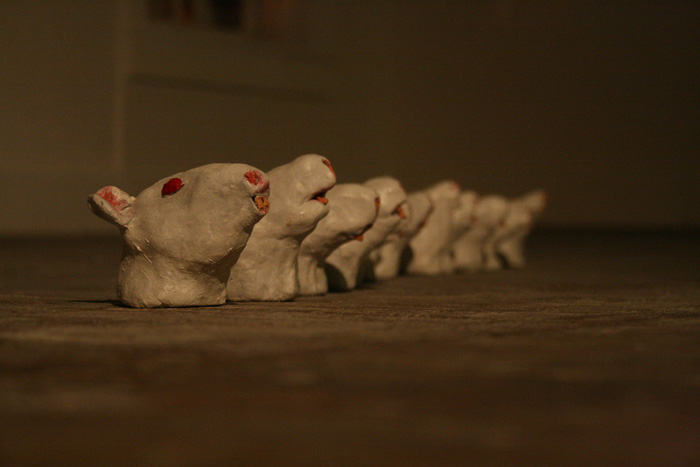Week 6: BioTech and Art
The beauty of the human race is its ability to change. The ability to modify, alternate, and create something new. This is especially true in the creation of art, but with the rise of biotechnology, artists are now becoming more aware of its integration at a biological level. More so the commentary that art could relate to current ethical grounds.
Marta Menezes this week discussed her early project in altering butterfly wings. On her first day in the laboratory, the scientist there asked her who gave her the right to chemically alter biological beings for the sake of art. They later concluded that she had the same right as fellow scientists as long she abided by the same ethical criteria when using animals in scientific studies. Personally, this type of manipulation still feels unsettling to me despite its simple signal interruption rather than fully modifying their DNA. However, at the mention of Edward Steichen’s breeding of flowers, I saw no problem at this direct change in their genes which I found odd. It placed me in a compromise ethical position because I justified my unsettlement due to the use of biotechnologies for the sake of an aesthetic, yet flowers don’t evoke the same response.Marta Menezes's altered butterfly from https://martademenezes.com/portfolio/projects/
The idea of a sentient being became the basis of this differential attitude. The ethical debate of a being’s moral status centers on the features or sets of features that a being has that are taken into account for them to be included in our moral decision-making. The problem is to collectively agree on these qualifying sets of features. This comes into play when designer babies get involved. Scientist projects the use of CRISPR as a gene-editing tool possible to select for “desired” human traits. I want to specially highlight the use of “desire” as a socially constructed perception of interests that fluctuates over time, therefore an invalid basis for genetically altering humans.
Finally, Kathy High furthers this debate in our ease in breeding laboratory rats, whose only purpose is to be sued in experiments. Through her Ratz installation, she depicted decapitated rat heads in clay along aside white chocolate rats to honor their lives in the name of research. Moreover, Embracing Animals was an installation created by High, again highlighting the treatment of these rats as a transformative nature. High then treats them like family instead of mere objects means to an end.
“1. Introduction.” The Ethics of Embryonic Stem Cell Research, by Katrien Devolder, Oxford University Press, 2015.
Center, Art|Sci, director. BIOTECH & ART- Marta Menezes. Vimeo, 6 May 2021, vimeo.com/532013903.
“Embracing Animal.” Kathy High, www.kathyhigh.com/projects/embracing-animal/.
“Marta De Menezes.” Marta De Menezes - The Museum for Insects, hypernatural.com/museum/marta_de_menezes.html.
“Ratz.” Kathy High, www.kathyhigh.com/projects/ratz/.
TEDEducation, director. How CRISPR Lets You Edit DNA - Andrea M. Henle. YouTube, YouTube, 24 Jan. 2019, www.youtube.com/watch?v=6tw_JVz_IEc&ab_channel=TED-Ed.
TEDxTalks, director. Biotechnology Can Be Beautiful | Keira Havens | TEDxFrankfurt. YouTube, YouTube, 20 July 2015, www.youtube.com/watch?v=tRYuN9GaN7I&ab_channel=TEDxTalks.
Vesna, Victoria, director. 5 BioArt pt5. YouTube, YouTube, 17 May 2012, www.youtube.com/watch?v=z7zHIdsFS3A&list=PL9DBF43664EAC8BC7&ab_channel=UCOnline.

I really enjoyed reading your blog! I definitely see your point with feeling unsettled when they edited the butterfly genes. I also learned about the designer babies in classes before, and found it really interesting how people want to use biotech to change the appearance of their babies. I think modifying genes can be good in curing diseases, but can also be scary when trying to change the appearance of entire babies.
ReplyDeleteHi Rose! I thought your blog topic was really cool - especially the reflection you did in the beginning about your own stance on the use of animals in art. I too found the use of animals in art disturbing - but only in certain circumstances. And strangely enough, the frequent use of rats in lab experiments does not invoke the same feeling of disturbance for me. Perhaps because this has been something I've grown up with and therefore is pretty normalized in my mind.
ReplyDeleteAdditionally, I also talked about the ethics of designer babies in my own blog and I completely agree with your perspective. I think that gene editing is really only justified/warranted if there is a medical risk (ex: if a parent has Parkinson's, which is a deadly dominant disease; meaning the child would have a 50% chance of inheriting the disease). To me, wanting certain traits - whether they be physical, personality-related, etc - does not feel very justified, especially since these desired traits can change, as you stated.